TABLE OF CONTENTS
It took a while, but we got there. NVIDIA’s launch of 3 refreshed graphics cards took only… an entire month and countless embargoes.
If we set aside all the marketing behind the ‘SUPER’ moniker, it’s easy to see that these new cards are essentially a way for NVIDIA to bring mid-cycle price cuts to its RTX 40-series lineup.
Is that bad? Not at all! It’s the ‘super’ long release window that’s pretty frustrating.
If nothing else, better value manages to spur AMD into (at least) competing for the value crown. Although AMD hasn’t officially responded to these SUPER cards other than announcing a ‘temporary’ discount on the Radeon RX 7900 XT, I hope they’re busy cooking something.
Final RTX 40 SUPER Lineup and Specifications
Before we dive into benchmarks and charts, let’s take a quick look at the complete RTX 40 SUPER series lineup.
| RTX 4070 | RTX 4070 SUPER | RTX 4070 Ti (Discontinued) | RTX 4070 Ti SUPER | RTX 4080 (Discontinued) | RTX 4080 SUPER | RTX 4090 | |
|---|---|---|---|---|---|---|---|
| VRAM | 12GB | 12GB | 12GB | 16GB | 16GB | 16GB | 24GB |
| GPU Die | AD104 | AD104 | AD104 | AD103 | AD103 | AD103 | AD102 |
| Shading Units (CUDA) | 5,888 | 7,168 | 7680 | 8,448 | 9728 | 10,240 | 16,384 |
| RT Cores | 46 | 56 | 60 | 66 | 76 | 80 | 128 |
| Tensor Cores | 184 | 224 | 240 | 264 | 304 | 320 | 512 |
| Base Clock/Boost Clock (MHz) | 1920 / 2475 | 1980 / 2475 | 2310 / 2610 | 2340 / 2610 | 2205 / 2505 | 2295 / 2550 | 2235 / 2520 |
| Memory Interface Width | 192-bit | 192-bit | 192-bit | 256-bit | 256-bit | 256-bit | 384-bit |
| MSRP (USD) | $549 | $599 | $799 | $799 | $1,199 | $999 | $1,599 |
NVIDIA RTX 4070 SUPER 12GB: A True Upgrade
A glance at the specifications proves that the only GPU to get some love was the RTX 4070 SUPER. It gets over 20% more CUDA, RT, and Tensor cores at the same price as an RTX 4070!
It’s certainly something if you’re willing to forget the fact that even the $599 price is a $100 price bump over the RTX 3070.
The RTX 4070 SUPER offers decent value at this price point, and considering its 2-slot width and relatively low power draw – it makes a LOT of sense for creative professionals.
NVIDIA RTX 4070 Ti SUPER 16GB: A VRAM Bump and Some
Of the 3 SUPER GPUs announced by NVIDIA, only the RTX 4070 Ti SUPER features a spec bump that includes VRAM capacity. It now offers a 16GB VRAM buffer compared to the outgoing RTX 4070 Ti’s 12GB with an MSRP of $799.
However, it doesn’t outperform the RTX 4070 SUPER by a wide enough margin to be enticing enough unless you need that extra VRAM.
What’s more, gamers can opt to go Team Red thanks to AMD’s price cuts on the Radeon RX 7900 XT, which is cheaper and offers similar rasterization performance (worse RT performance).
NVIDIA RTX 4080 SUPER 16GB: A Price Cut
The final piece of the ‘SUPER’ puzzle is the RTX 4080 SUPER – and it’s pretty much an RTX 4080, but cheaper – with a $999 MSRP. It boasts just over 5% more CUDA, RT, and Tensor cores than the GPU it’s replacing. So, the RTX 4080 SUPER is effectively a price cut and NOT a new GPU.
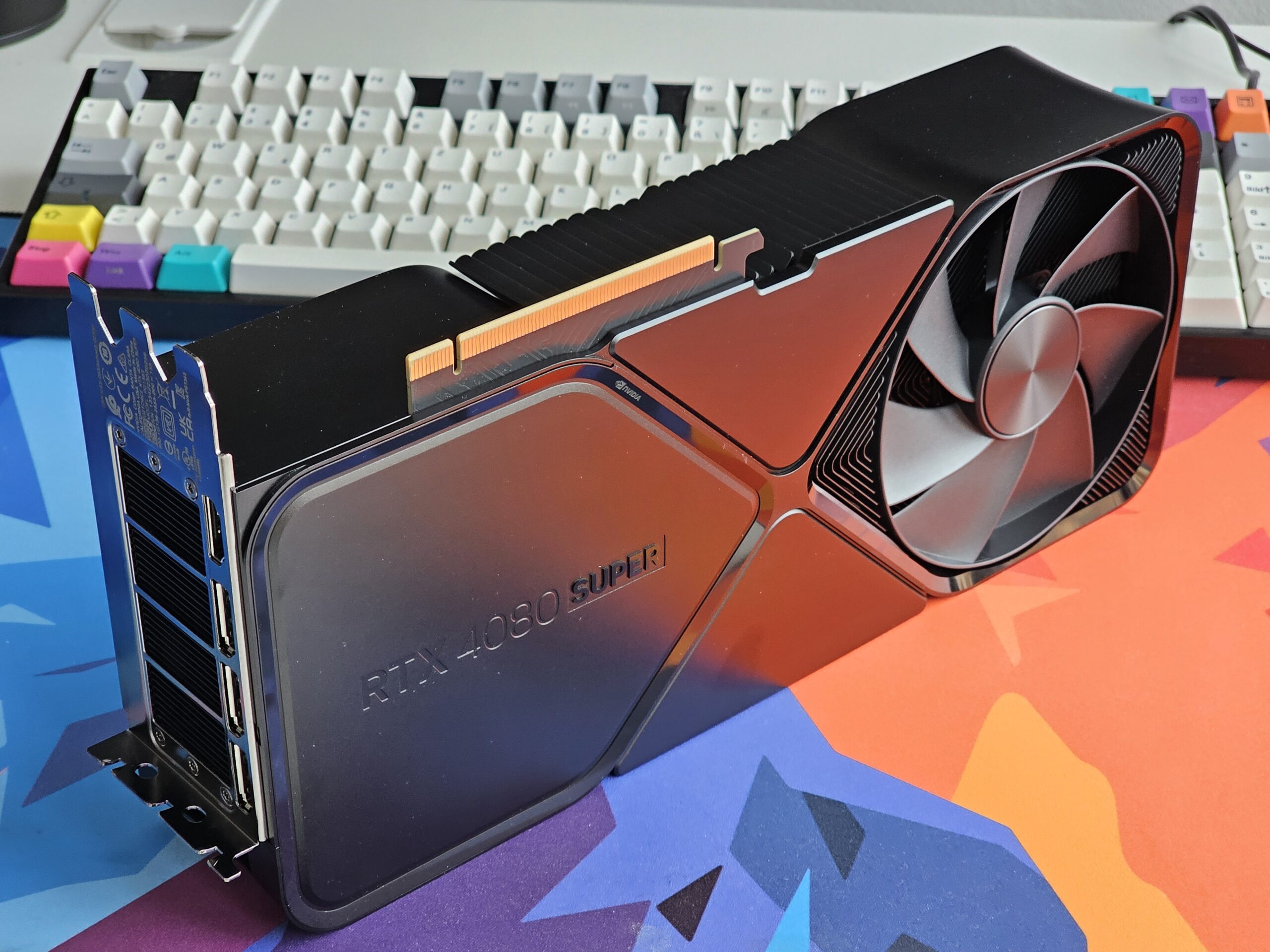
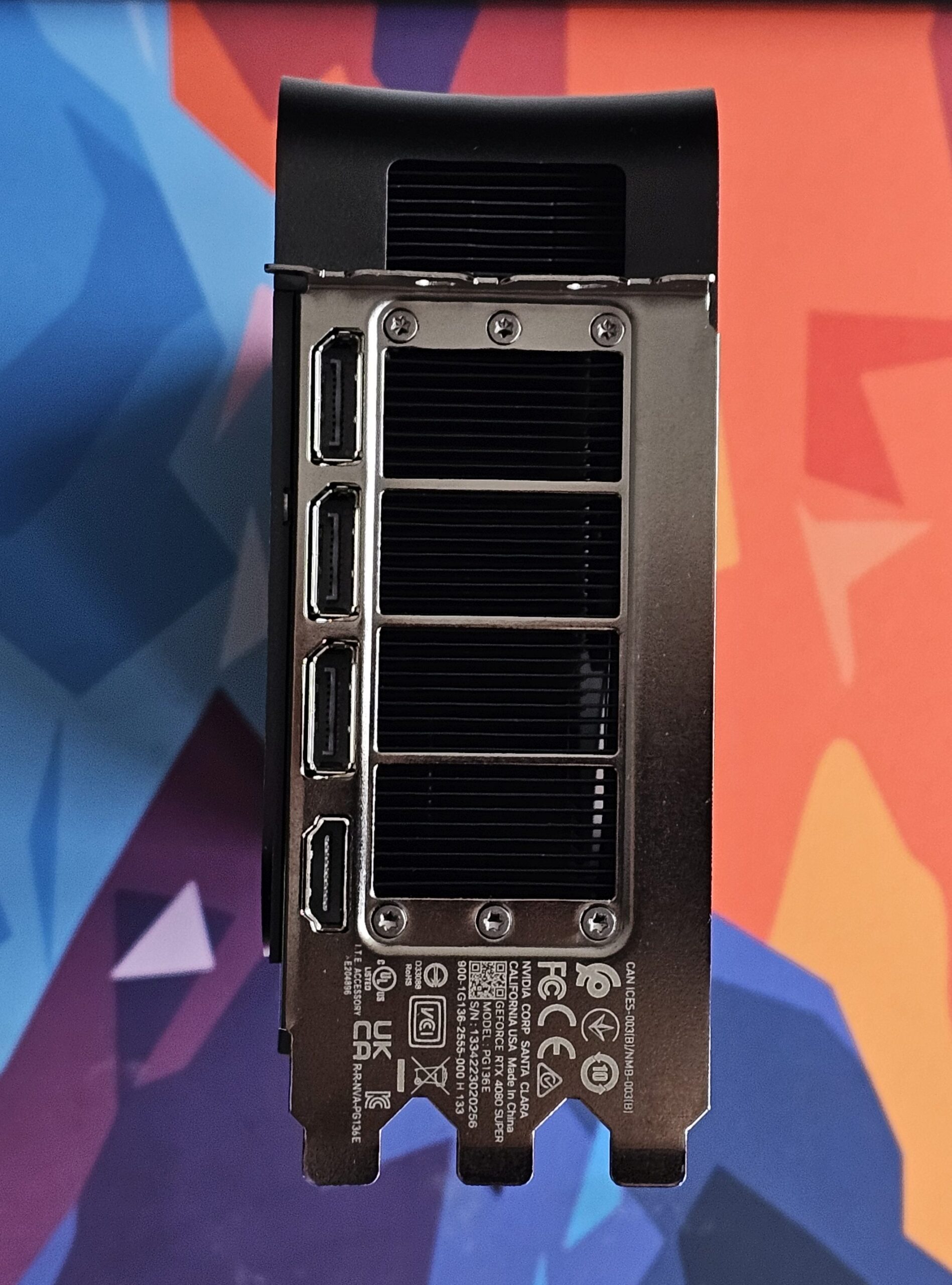
Since NVIDIA is in no hurry to bridge the humongous gap between its 80-series and the monstrous RTX 4090, the RTX 4080 SUPER is the only high-end GPU for gamers and professionals who want the best under $1000 (plus taxes).
Test Bench for the RTX 4080 SUPER Benchmarks
| CPU | AMD Ryzen 9 5900X |
|---|---|
| CPU Cooler | beQuiet! Dark Rock Pro 4 |
| RAM | 4x DDR4-3600 32GB (128GB total) |
| Motherboard | MSI Prestige X570 Creation |
| Storage | Seagate FireCude 530 Pro 2TB |
| OS | Win 10 Pro 64 Bit |
We’ll run our tests on a workstation machine featuring the AMD Ryzen 9 5900X and 128GB of DDR4-3600 memory. A faster CPU would enhance performance in some workloads, but mostly, you’ll see similar performance when running a primarily GPU load.
That said, if you’re building your machine in 2024, please do opt for AMD’s AM5 platform or Intel’s Z760/790 chipsets.
RTX 40 SUPER Series Performance Review and Benchmarks for Typical CG Workloads
Although we did publish dedicated articles for the two SUPER GPUs that launched earlier in Jan, looking at the complete lineup will probably be more relevant for anyone planning an upgrade. What’s more, it’s difficult to expect everybody to keep up with a month-long release window for a mostly dull mid-cycle refresh.
So, what do you need if you’re looking for a graphics card to upgrade your workstation?
Creative workloads like GPU rendering can use all the GPU horsepower you throw at them. On the other hand, working on an active scene within a viewport typically demands more from your CPU than your GPU.
GPU Rendering Benchmarks for RTX 4070 SUPER, RTX 4070 Ti SUPER, and RTX 4080 SUPER
A CPU can’t really touch a GPU when it comes to parallelization, which is why GPU rendering is one of the most popular ways to get a final render quickly.
That said, a GPU does lose its speed advantage when your scene exceeds the size of your VRAM buffer, and if it happens often enough, CPU rendering becomes a much better option.
Maxon Redshift Benchmark 3.5.22
Redshift is a popular render engine among CG artists who want to leverage their GPUs to complete a render, and it certainly helps that ever since Maxon acquired Redshift, it has become much more closely integrated with Cinema4D.
Although Redshift uses multiple GPUs pretty well, it doesn’t scale linearly. So, a single powerful GPU is still more relevant for this workload.
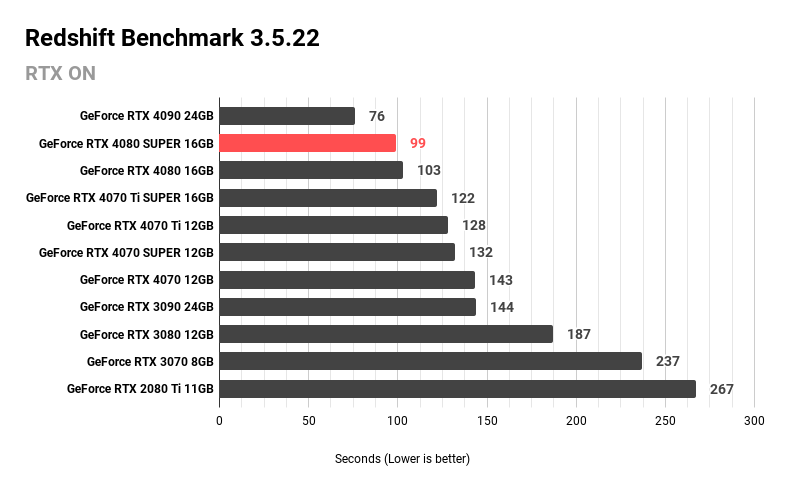
As expected, the RTX 4090 is in a class of its own, and the RTX 4080 SUPER comes nowhere close to it.
The RTX 4080 SUPER barely ekes out a lead over the outgoing RTX 4080 at a lower price, while being MUCH faster than an RTX 4070 Ti SUPER (nearly 20% reduction in render times).
What about the rest of the lineup?
First, the RTX 4070 Ti SUPER. Although its performance does sit between the RTX 4070 SUPER and 4080 SUPER, its nearly 3-slot width downgrades it to only an ‘okay’ option.
I recommend dropping to the RTX 4070 SUPER if your budget is limited to under $800. This way, you’ll have a performant 2-slot GPU that doesn’t take up all the slots on your motherboard – giving you the freedom to add more cards in the future.
Octanebench 2020.1.5
Nothing comes close to leveraging multiple GPUs like Octane Render does, as it offers nearly linear scaling when adding multiple GPUs. This is relevant because multi-GPU setups become even more viable here, and accommodating additional GPUs should be a factor to consider.
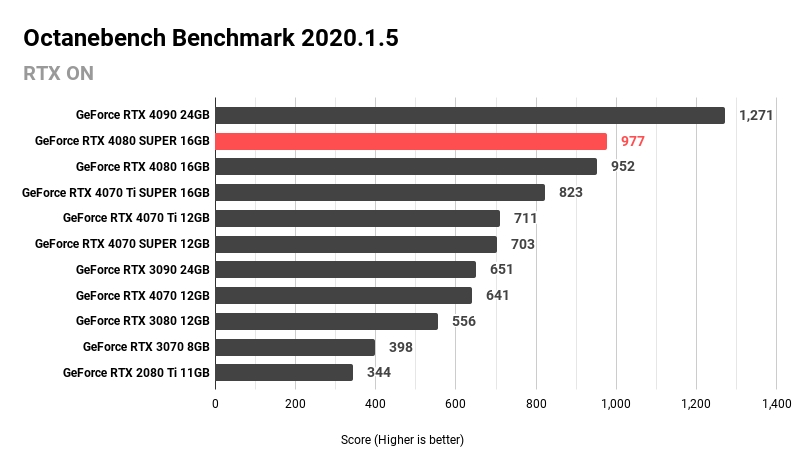
In Octanebench, the RTX 4080 SUPER falls flat when pitted against the RTX 4080 – delivering a measly 2% uplift. However, it does manage to outpace the RTX 4070 Ti SUPER by an ~18% margin and the RTX 4070 SUPER by a ~39% margin.
If you don’t want to completely max out your PCIe slots with up to 4 GPUs, the RTX 4080 SUPER at a $999 MSRP is a better option than the RTX 4070 Ti SUPER for a single powerful GPU (other than the RTX 4090 at MSRP). However, the RTX 4070 SUPER is still the way for Octane Render if you want the flexibility to add more GPUs to your workstation.
V-Ray 6
V-Ray 6 GPU offers a convenient option for professionals working with apps like Rhino, Revit, 3dsMax, etc. Although its GPU rendering capabilities are relatively new (version 3.6 and newer), it has matured over the past few years and is now considered a solid choice.
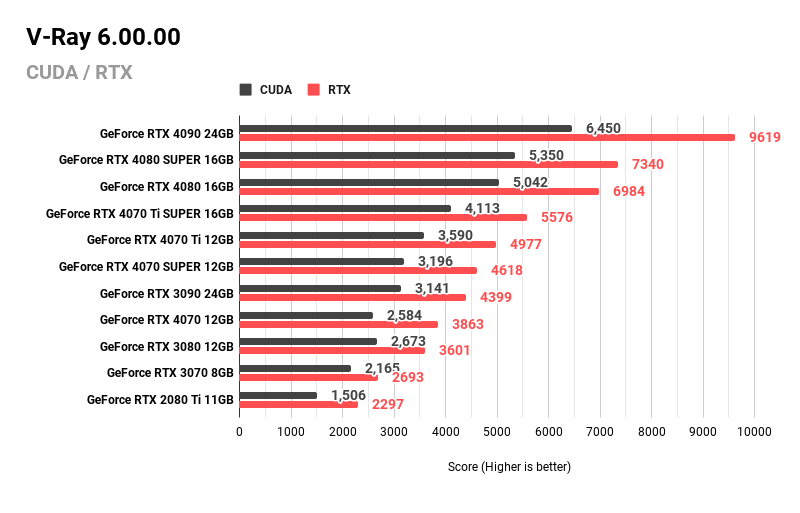
As we’ve seen, the RTX 4090 is leagues ahead of everything else in NVIDIA’s lineup, including the new RTX 4080 SUPER. Again, the RTX 4080 SUPER’s trend of offering a marginal improvement over the outgoing RTX 4080 continues with a 5% performance uplift.
In V-Ray’s RTX GPU bench, even the RTX 4070 Ti SUPER isn’t too bad – managing a 20% higher score than an RTX 4070 SUPER.
But again, V-Ray does scale with multiple GPUs quite well, so if you want the additional horsepower from a single card, you’re better served by the RTX 4080 SUPER, which is a good deal faster (30%) than the RTX 4070 Ti SUPER.
Blender GPU Benchmark (Cycles – Optix/HIP)
AMD’s Radeon GPUs finally make an appearance with Blender’s GPU benchmark thanks to its HIP implementation in Blender’s Cycles renderer. I don’t expect stellar performance from AMD here until HIP-RT makes it out of Blender’s experimental branch.
In its current state, crashes, and artifacts in the final render make it unviable for real-world projects.
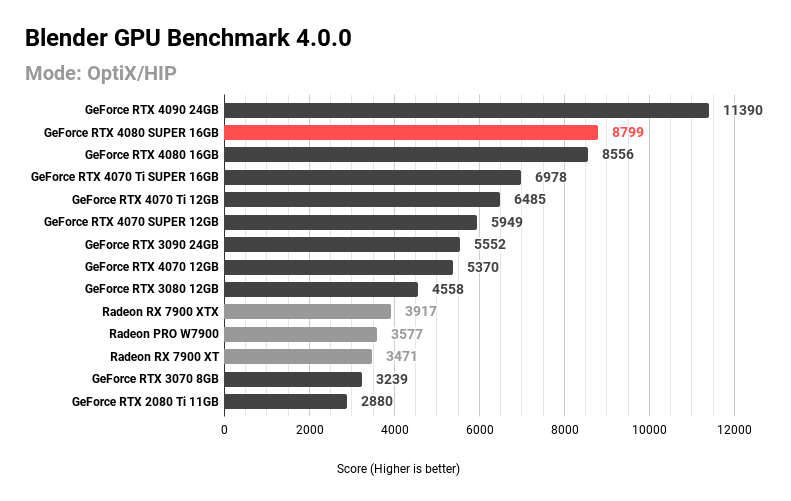
In Blender, the RTX 4080 SUPER looks far less impressive than we expected, with a mere 2% uplift in performance compared to an RTX 4080.
The RTX 4070 Ti SUPER is much slower than the RTX 4080 SUPER here, with a 20% lower score, while the RTX 4070 SUPER is another 15% slower.
A glance at the chart confirms that Radeon GPUs can’t keep up with NVIDIA’s current-gen offerings. In fact, the RTX 4070 thoroughly trounces the AMD Radeon RX 7900 XTX at nearly half the price. But as I said, this is expected behavior because the Cycles renderer still isn’t using AMD’s RT cores. We’ll have to wait for better support to see some competition here.
Scaling with multiple GPUs is a thing, but it isn’t super linear. Keeping this in mind, you should be on the lookout for a single powerful GPU before considering an additional GPU for most Blender workloads.
The RTX 4080 SUPER at its MSRP does make sense here (if an RTX 4090 isn’t an option).
Cinebench 2024 GPU Benchmark
To get accurate, sustained results for Cinebench, we record our numbers after a 10-minute run of each card. Not only does this mimic an actual workload much better, but it also allows us to eliminate any thermal concerns with the cards on hand.
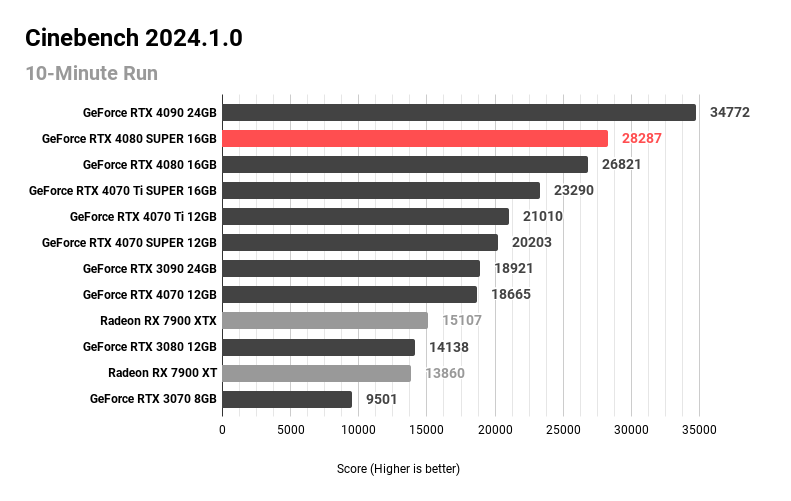
In what’s become a recurring theme now, the RTX 4080 SUPER delivers a 5% performance boost over the RTX 4080. However, the price cut does make it relatively more ‘palatable.’
What about the RTX 4070 Ti SUPER? Well, an RTX 4080 SUPER is 20% faster than it, and an RTX 4070 SUPER is 13% slower.
NVIDIA seems to specialize in (intentionally) sticking products into weird spots where your options are buying a better value card by spending more or being content with a lower performance at a better value.
Autodesk Arnold GPU Benchmark
Arnold is one of the most popular render engines out there because it’s developed by Autodesk – and enjoys excellent integration with several pro apps.
Benchmarking Arnold was challenging for various reasons, but Antonio Bosi’s custom scene made it much easier.
![Maya 2024.2 _ Arnold 7.2.5.1 [GPU]](https://www.cgdirector.com/wp-content/uploads/media/2024/02/Maya-2024.2-_-Arnold-7.2.5.1-GPU.png)
First, the RTX 4080 SUPER matches the RTX 4080 and delivers nearly identical performance at a lower price. What’s more, the RTX 4070 SUPER looks pretty good from a value standpoint compared to the rest of the product lineup.
If you’re using Arnold to render your scenes, the RTX 4070 SUPER or the RTX 4080 SUPER are your best options in today’s market.
Motion Graphics and Animation Benchmarks for RTX 4070 Ti SUPER: Adobe After Effects
Although After Effects does use the GPU, its performance doesn’t scale well past a certain ‘sweet spot.’
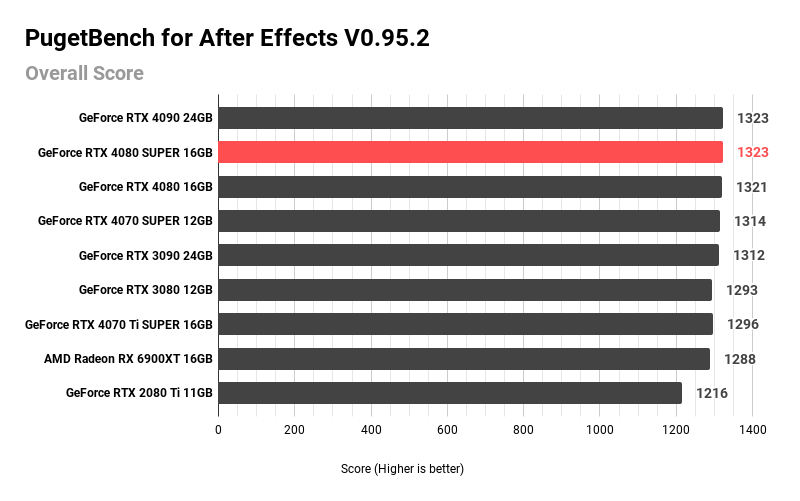
As expected, the new RTX 4080 SUPER matches the RTX 4090 in Puget System’s After Effects benchmark because additional GPU horsepower doesn’t do anything.
![do-something-comeon[1]](https://www.cgdirector.com/wp-content/uploads/media/2024/02/do-something-comeon1-300x285.gif)
However, parts like the RTX 4080 SUPER don’t offer anywhere close to decent price-to-performance compared to parts like the RTX 4070 SUPER. For most After Effects work, grab an RTX 4070 SUPER at its MSRP and call it a day.
That said, what if you’re using GPU-heavy plugins? Well, the picture changes quite a bit.
![[CGDirector] After Effects Custom GPU Scene](https://www.cgdirector.com/wp-content/uploads/media/2024/02/CGDirector-After-Effects-Custom-GPU-Scene.png)
In our custom benchmark run, we used a combination of NeatVideo DeNoise, Magic Bullet Looks, and VideoCopilot Optical Flares to put additional strain on the GPU to see how they handle these loads.
Now, an RTX 4090 outperforms everything else by a decent margin, as expected. Surprisingly, the RTX 4070 Ti SUPER looks like the best value here, thanks to its lower price and 16GB VRAM buffer. It comes within spitting distance of an RTX 4080 SUPER and matches the RTX 4080.
If you’re using any of these or a combination of these plugins with After Effects, the RTX 4070 Ti looks like the way to go if you can find it for MSRP.
Video Production Benchmarks for the RTX 4070 Ti SUPER: Adobe Premiere Pro and DaVinci Resolve
PugetBench for Premiere Pro
A single powerful GPU has been the best way to go for Premiere Pro, and this hasn’t changed. Even though you start to see significant performance regression at the higher echelons of performance, factors like additional VRAM and/or GPU horsepower can vary from professional to professional.
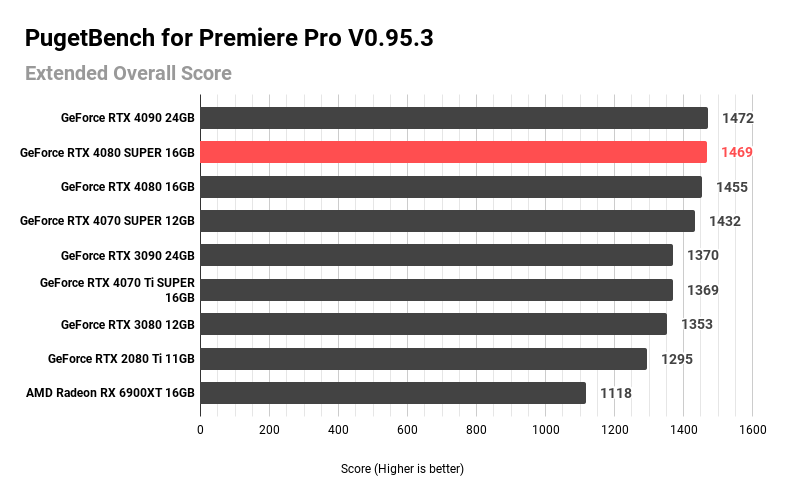
In PugetBench, the SUPER GPUs are nearly even, with the value clearly going to the RTX 4070 SUPER. The RTX 4070 Ti SUPER gave us funny results, but we retested it several times to end up at scores much lower than even the RTX 4070 SUPER.
I’d chalk it up to a bug in either drivers or Premiere Pro, so just ignore that result for now.
So, what GPU should you buy for Premiere Pro workloads? The answer is – RTX 4070 SUPER if you want the best value.
You should spend more only if you need additional VRAM for your projects.
PugetBench for DaVinci Resolve
DaVinci Resolve has typically been better at using the GPU horsepower thrown at it, and we can expect better scaling than Premiere Pro here. What’s more, it can also leverage multiple GPUs for additional performance (not linear).
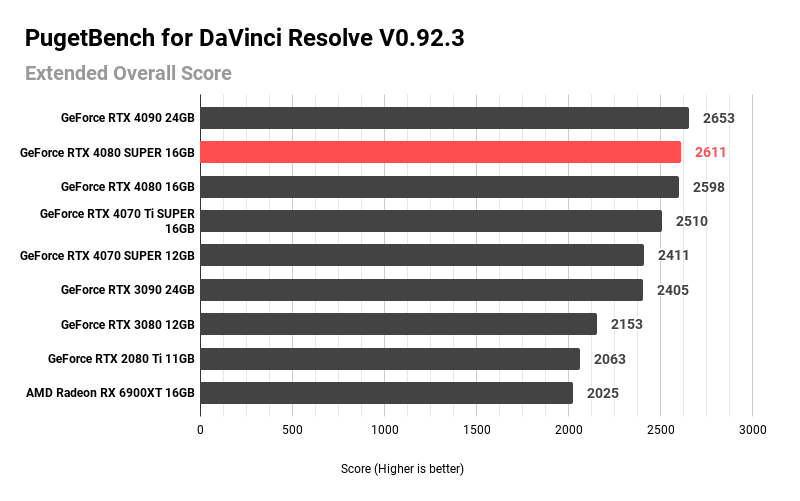
Here, the RTX 4080 SUPER and the RTX 4080 are within the margin of error, so again, it’s a price drop with basically the same GPU. The RTX 4080 SUPER is only 4% faster than an RTX 4070 Ti SUPER and 8% faster than an RTX 4070 SUPER – making it a terrible value product in general.
With these scores, the RTX 4070 SUPER is probably the right way to go unless the 12GB VRAM buffer makes it a no-go for your workloads.
Stable Diffusion Benchmark for RTX 4080 SUPER: txt2img, 512×512, TensorRT
Now that Stable Diffusion has become all the rage, assessing whether a GPU upgrade will deliver a noticeable performance improvement is important. Artists are starting to use it as sort of a quick prototyping tool to improve their workflow.
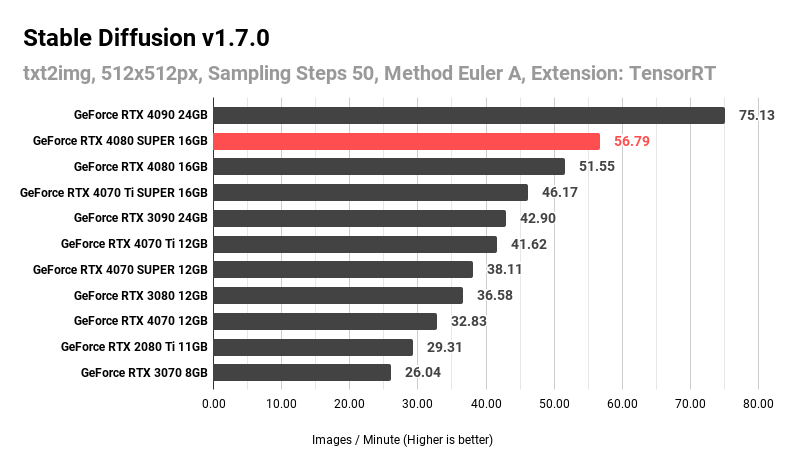
The RTX 4080 SUPER delivers a 10% improvement over the RTX 4080 and easily outpaces the rest of the NVIDIA product stack. A larger VRAM buffer does help, as can be seen in the results where the RTX 4070 SUPER loses out to the RTX 3090 – a card it consistently beats across several workloads.
For Stable Diffusion, if you want the quickest results without splurging on the RTX 4090, the RTX 4080 SUPER is the way to go.
Power Consumption Analysis of the RTX 4080 SUPER: Power Draw, Perf/Watt, and Peak Power Draw
Since the RTX 4080 has been among the most efficient GPUs in this NVIDIA lineup, we can expect the SUPER variant to deliver much of the same. First, we’ll start with a maximum power draw test to see the peak loads drawn by several professional and gaming workloads.
![RTX 4080 SUPER Maximum Power Draw [Stress, Game, 3D GPU Render]](https://www.cgdirector.com/wp-content/uploads/media/2024/02/RTX-4080-SUPER-Maximum-Power-Draw-Stress-Game-3D-GPU-Render.png)
The results are pretty great for the RTX 4080 SUPER. It draws only a max of 235W during an Octane render, while Blender and Redshift numbers are much lower at 209W and 191W, respectively.
Gaming does put much more strain on the GPU, which now draws 288W of power to handle Shadow of the Tombraider at 4K (Ultra, DLSS ON, RT ON). Of course, Furmark takes it to the extreme, and the RTX 4080 SUPER draws a whopping 318W.
For our purposes, we’ll focus on the Octanebench numbers to better understand the GPU rendering efficiency you can expect with the RTX 4080 SUPER.
![Total Board Power Draw [Average] - Octanebench 2020.1.5](https://www.cgdirector.com/wp-content/uploads/media/2024/02/Total-Board-Power-Draw-Average-Octanebench-2020.1.5.png)
As you can see in the average power draw chart above, the RTX 4080 SUPER draws less power than an RTX 4080 and not much more power than an RTX 4070 Ti.
These numbers should place it in the top tiers of efficiency (performance per Watt).
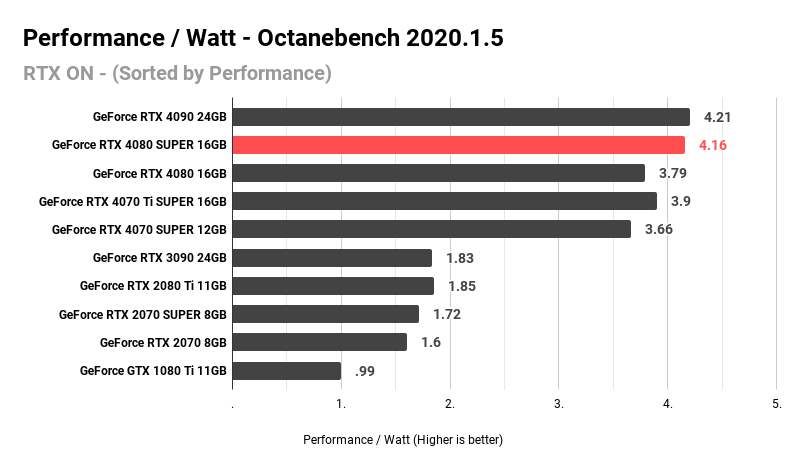
And as expected, the RTX 4080 SUPER nearly tops the chart with a performance per Watt of 4.16, which is beaten only by the monstrous RTX 4090. If you’re looking to do the most work for the least amount of power, the RTX 4090 and the RTX 4080 SUPER are your best choices.
Pricing Analysis of the RTX 4080 SUPER: The Almighty Performance/Dollar
Although knowing performance numbers does help you make a decision, nothing captures value like a performance per dollar chart does. For this chart, we’ll be using our Octanebench numbers.
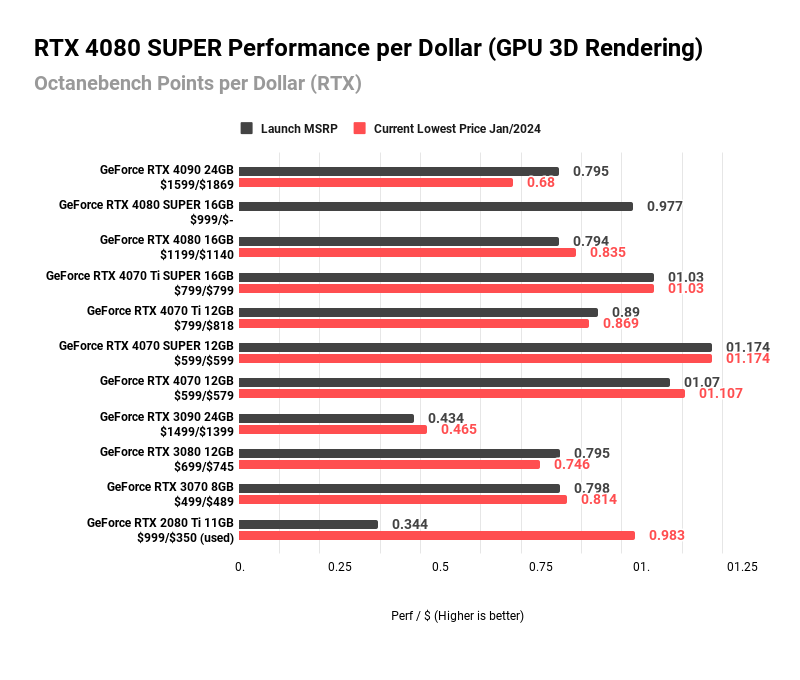
As you can see, NVIDIA remains glued to that 0.9 – 1.0 perf/$ number even with the RTX 4080 SUPER’s price cut. Out of all the newly-launched products, the one that offers better value than anything else is the RTX 4070 SUPER.
Unfortunately, neither the RTX 4080 SUPER nor the RTX 4070 Ti SUPER do much to swing the needle here. Since AMD isn’t a viable option for most of our workloads (yet), CG artists are at the mercy of NVIDIA.
Verdict: Which SUPER Graphics Card Should You Buy?
When it comes to value, only the RTX 4070 SUPER is worth talking about. The other NVIDIA GPUs make no attempt to upset the status quo, and after watching AMD’s moves over the past few years – it’s in no hurry to compete aggressively either.
Where does that leave us?
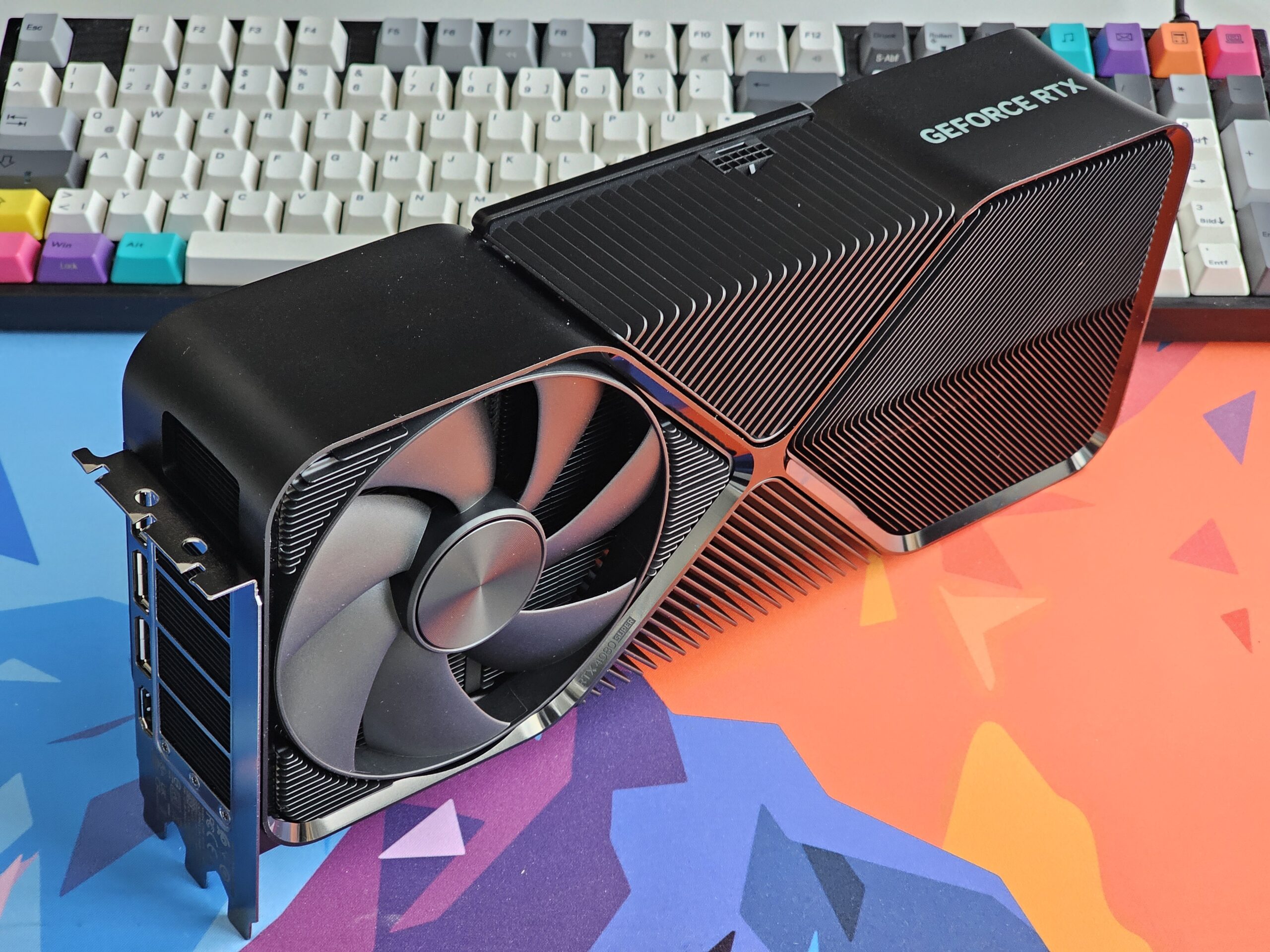
If your work depends on faster GPUs, you can’t wait forever. If you want a single powerful GPU but don’t have the budget to stretch to the RTX 4090, the RTX 4080 SUPER at its MSRP would be a decent pick.
However, from what we can see online, RTX 4080 SUPER GPUs at MSRP are hard to find, and the attempts to snag one are probably triggering mining-era PTSD among gamers and professionals.
If you CAN wait, then wait. Next-gen GPUs aren’t that far out, as rumors point to a release late this year or early next year. They should (hopefully) offer better value.
RTX 40 SUPER Series Launch: A Quick Rant
While price cuts and more performance are good things, a month-long release window with multiple embargoes puts a damper on the whole thing. Not only does it fatigue the media trying to cover it, but it also fatigues prospective buyers.
For the average joe, it’s nearly impossible to keep up with what cards are releasing when and what performance to expect because all the information they get is incomplete. Look at the RTX 4080 SUPER launch, for example.
You’ll see graphs that were published 2-3 weeks ago, with a single data point added to it from multiple outlets. The embargo on performance data shouldn’t be spread out over a month for something as mundane as a mid-cycle refresh.
It looks like NVIDIA wants the fanfare of a full product launch without a new product. But people quickly get bored and look away if there’s nothing major to see.
![NVIDIA RTX 4080 SUPER GPU Review [Content Creation, Rendering, AI] NVIDIA RTX 4080 SUPER GPU Review [Content Creation, Rendering, AI]](https://www.cgdirector.com/wp-content/uploads/media/2024/02/20240131_150445-1200x675.jpg)
![GeForce RTX 4070 SUPER Reviewed for CG Workloads: NVIDIA’s New Value King [Review] GeForce RTX 4070 SUPER Reviewed for CG Workloads: NVIDIA’s New Value King [Review]](https://www.cgdirector.com/wp-content/uploads/media/2024/01/CGDirector-Nvidia-RTX-4070-SUPER-Review-18-594x335.jpg)
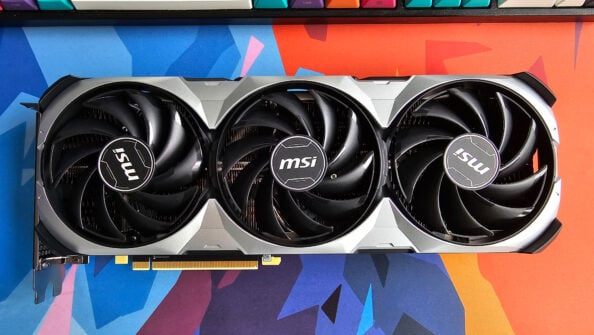
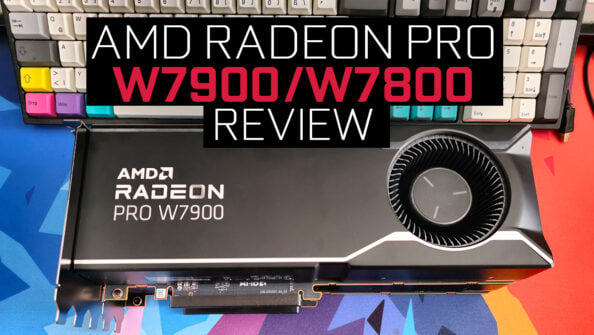
![Nvidia GeForce RTX 4080 16GB Review [Content Creation, Rendering, & Power Draw] Nvidia GeForce RTX 4080 16GB Review [Content Creation, Rendering, & Power Draw]](https://www.cgdirector.com/wp-content/uploads/media/2022/11/Nvidia-RTX-4080-16GB-Review-Content-Creation-Rendering-Power-Draw-Twitter-594x335.jpg)

0 Comments